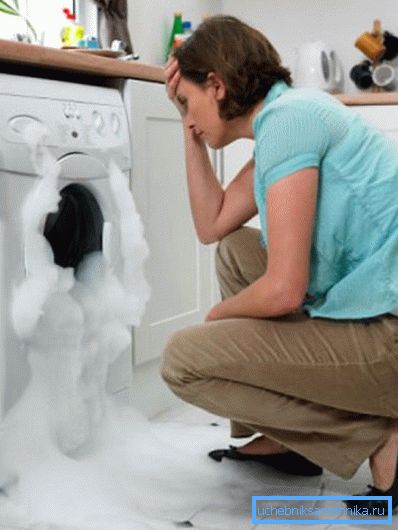Drain the washing machine in the sewer: the rules for the
Like any modern household appliances, a washing machine requires proper installation. Given the high cost of this device, it is better to do everything right away, so that it is easy. As part of this article, we will look at the sewage system for a washing machine, its connection and proper equipment operation.

Installation and connection
Stages of work

So, we need to solve several problems:
- Deliver and prepare the device for installation. This is a rather complicated and expensive device, so we advise you to carefully consider this item;
- Choose a location for the device. This is also important, as the ease of use and some nuances of connecting the machine to communications will depend on the said choice;
- Connect the machine to the engineering communications systems: plumbing and sanitary. Clean water will come from the first source, and dirty water will drain into the sewage system;
- Connect the device to the power supply system;
- Perform test or test launches to make sure that everything was done correctly and problems in the future should not be expected.

Water pipes

To connect the device to the water supply system, it is enough to connect a flexible hose to any point of the water intake: a mixer, a shower system, a cold water supply pipe.

Note! The only note is the presence of valves, otherwise in the event of a repair or accident you will not be able to disconnect the device from the communication pipe.
Further, everything is simple: we connect the 3 \ 4 hose to the tee of the sewage system, which we cut into the pipe going to the sink in advance.

Sewage

We go further. Now we need to connect the waste water outlet to the sewer line.
There are various options for solving this problem:
- Drain into the bathroom or washstand. This is wildness;
- Connection to sink or bath siphon. Acceptable option;
- Connect directly to the sewer pipe. In general, the most reliable option.
In fact, the drain from the washing machine into the sewer is a branch pipe that must be connected to the hole on the back of the appliance and the pipe. Nothing military. The easiest and proven method is to connect a washstand in the bathroom or in the kitchen to the siphon; it is elementary to do all the manipulations with your own hands.
To do this, purchase a siphon with an additional opening for the inlet of the dirty waste water from the washer and replace it with the old one. This is done in half an hour by any healthy person.

Next, you need to make sure that the length of the pipe to drain from the machine is sufficient, and it is not stretched like a string, and hangs freely in the mounting position.

Siphons and nozzles are calibrated, equipped with cuffs and gaskets, clips, etc., so your task is to simply insert the hose into the hole and clamp it with a screw-on cap-clamp.

Note! Buy siphons from proven manufacturers, made from quality materials and equipped with non-return valves. It saves you a lot of time and nerves.
Then the second end of the nozzle for draining sewage is connected to the machine with the help of fittings and other additional elements and parts. How to do this for highly technically capable people is a detailed instruction of the manufacturer of the washing machine. (See also the article Sewer coupling: features.)

Note! As can be seen in the diagram, the drain is started up from the bottom up, and it is desirable that the distance from the top to the floor be at least 800 mm. This will simplify the work of the drain pump.

There is no need to consider the power supply separately - you connect the grounding to the appropriate wire or use euro outlets, where it is provided for by the construction. Only then it is better to install an automatic switch that will open the network in the event of a short circuit and the machine will not burn.
Note! Never, under any circumstances, do not ground anything to batteries and plumbing pipes. This is a very serious violation of SNiP and more serious regulations.
Test

Everything is simple: open the water supply tap, turn on the device in the outlet, set the most usual mode, load a small amount of laundry, pour the powder and press the "start".
If you hear the sound of collecting water - fine, then it will begin to warm up - great, finally - the drum will spin, and this is a victory!

Of course, we will wait for the end of all the regimes and see how the water has been squeezed out and merged, and then we can say with a clear conscience: “Hurray, that's it!”
Conclusion
The beauty of modern technology is its simplicity. Therefore, do not be afraid, but rather read the instructions - and feel free to install any kitchen unit. The video in this article is visual proof of our words.